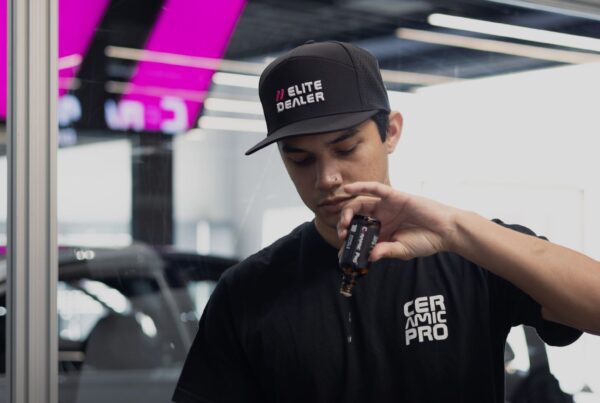As a company that helped to pioneer the automotive ceramic coating industry, we sometimes pause and chuckle at the plethora of new ‘miracle coatings’ popping up on the internet. Whether it’s the new buzz term “Graphene Coatings” or the DIY version of a 9H ceramic coating that’s “easy to apply”, the range of products being peddled to car enthusiasts is getting rather pathetic to be blunt. But are these DIY ceramic coatings safe to apply yourself?
Let’s be clear – a professional ceramic coating is highly concentrated chemical formulation. It’s comprised of lab-created ingredients that are not good to inhale, consume, or get on your hands. The liquid is very sticky – and once it hardens (within a matter of seconds on flesh) it’s like super glue. The same thing applies to the DIY copycats. After all, there is a reason why most of the DIY ceramic coating kits come with nitrile protective gloves.
So, are these protective coating products safe for the average car owner to apply themselves? In short, assuming you wear the right protective equipment, and are proactive about ensuring you have a well-ventilated area, you should be OK to install on your car’s surface. But it’s important to be open and honest about what’s included in these products – which is nearly impossible to find on their websites.
Below, we will go over what kind of ingredients are most often found in DIY coatings, explain how you can protect yourself if you are accidentally exposed to a harmful ingredient, how it differs from carnauba or car wax, what aspect of it causes swirl marks to be amplified, and some other important facts that many manufacturers and car detailers do not disclose to consumers.
What are Ingredients in a Ceramic Coating Product?
A typical ceramic paint coating is a nano liquid polymer consisting of several ingredients working together to generate a protective layer for vinyl wrap, glass, metal, etc. and the car’s paintwork. A professional coating and DIY ceramic coating kit has a lifespan longer than that of wax, repels brake dust from wheels, improves windshield visibility, improves the longevity of a vehicle’s paint, and reduces how often you need to wash your car.
Well – at least, that’s what ceramic paint protection coatings do – and what many DIY variants attempt to replicate. Here is another dose of truth – the best DIY nano ceramic coatings are about 50% as effective at providing superior protection vs a professional grade coating – like Ceramic Pro 9H.
That’s not speculation – it’s documented fact. The main reason is the range of variables that goes into applying and caring for the car ceramic coating. That’s why you will never find a documented warranty on the longevity of the product. They are also not installed by an accredited detailer. Some mobile guys might offer the service, but pro-shops stay clear of them for the most part.
Sure, you might find a handful of companies that will refund your money if you don’t get two years out of the product, but they’re betting you won’t bother to contact them. Even if you do – it’s a loss of $5 to $10 to them – as that’s basically what these companies cost of goods is. Don’t believe me – click this link to see the root product sold on Ali-Baba.
So, what is included in these DIY nano coatings you see online? Well, we did a bit of research, and found this based on an SDS sheet sent to us by the Chinese supplier linked above.
Here are the ingredients inside DIY ceramic nano-coating – which looks nearly IDENTICAL in packaging – even in advertising / marketing language to a leading DIY coating brand.
Silicon Dioxide – SiO2: Silicon Dioxide (sometimes called silica dioxide) is a ceramic ingredient that helps produce the hard – yet flat hydrophobic smooth surface that nano coatings are known to produce. Contrary to what some DIY coatings claim on their websites – this is NOT the ingredient that determines the strength of the coating. That would be titanium dioxide or TiO2 – and the carrier solvents that allows the coating to be layered with a professional grade coating.
Titanium Dioxide – TiO2: The ingredient that helps produce the hardness and longevity (the 9H thing) is titanium dioxide or TiO2. Most DIY ceramic coatings are comprised of lower percentages of TiO2 vs professional grade coatings – as this reduces the margin of error for application. Since they formulate these products for DIY applications, they simply can’t add much TiO2 to their blends.
Silicon Particles: One of the best attributes of a nano ceramic coating is the fact that it enhances the depth of car paint – and even plastic trim parts. In a professional grade coating, this is accomplished by layering the product – as the more layers of glass coating, the more intense the depth. DIY coatings don’t have this ability – so to replicate the effect, they add particles of silicon for added brightening.
There are other minor ingredients such as Fluorine, Triethanolamine, PolySilazane, and water. The only ‘safe’ product to use without PPE is water. So, if you’re going to dabble in ceramic coating installation yourself, make sure to wear protective gloves, a breathing respirator, and eye protection – especially if you do the installation in a controlled indoor environment – which is highly recommended for best results.
How to Handle Exposure to a DIY Ceramic Coating
A concentrated ceramic coating is 180-degrees from traditional wax. Most carnauba paste wax is made with natural ingredients – even the lab created stuff is relatively harmless. Anytime you work with a chemical, it’s important to know how to handle accidental exposure.
Since most DIY coatings do not actively post their ingredients on their website, or make it easy to provide health guidelines due to being ingested, inhaled, or contact with skin, we’ve put this list together of what you should do if you’re exposed.
Inhalation
If you inhale the fumes of a paint coating – especially over extended time, it’s important to follow a few important steps. First, reduce the potential of this type of exposure by wearing a protective mask or ventilator mask. Second, you should keep windows or the garage door open, for proper air flow.
For those not able to or choosing not to follow these guidelines, make sure to stop applying the coating if you feel dizzy, light-headed, or sick to your stomach, walk outside and get some fresh air. It’s a good idea to sit down for a while until you’re feeling better – and ONLY return to the installation with PPE.
Exposure on Skin
There is a reason the best DIY coating kits come with nitrile gloves. Nano coatings are very sticky – and will bond to virtually anything – even skin. If it gets on your hands, arms, legs, or other parts, it can be very tricky to remove. It can also cause light burns if your skin is sensitive to chemical exposure.
In the event of skin exposure, stop the application process and wash the area with warm water and soap ASAP. When you’re finished, dry the areas gently. If a rash or skin damage occurs, consult a medical professional.
Exposure to Eyes
Wearing safety glasses will significantly reduce the potential of exposure to eyes. However, it’s possible for fumes to come into contact with your eyes still. If this happens, flush the eyes with cold water ASAP. If vision is impaired or blurry afterwards, consult a medical professional.
Ingested or Swallowed
I’m not quite certain how this is possible – but if you happen to swallow some ceramic coating, it’s best to rinse your mouth with water ASAP. A phone call to the poison hotline should be your next step.
How Does Ceramic Coating Work?
So how exactly does ceramic coating work? When you apply a ceramic coating to a surface, it creates a protective layer resembling a shell that is smooth, flat, and much harder than waxes. This video below will explain the science behind Ceramic Pro 9H professional nano coatings.
The coating’s properties help reduce anything from sticking to the surface it is protecting, such as water, dirt, dust, bugs, contaminants, tree sap, bird droppings, and anything else that would be difficult to remove. This makes the process of washing your car much simpler and easier, since there will be less to clean in the first place. Additionally, the anti-stick property could at least reduce the effect that spray paint can have, which can prove helpful in case someone gets angry with you.
Here are some of the biggest benefits provided by ceramic coating:
Protects against UV damage: When the sun beats down on a vehicle all day, the car’s clear coating on the paint’s surface slowly starts breaking down. UV rays penetrate this weakened clear coating and thus the paint itself starts oxidizing, leading to dulling and fading of the paint’s color.
Protection Against Chemical Damage/Stains: Cars are often exposed to harsh chemicals which cause a ton of problems. Due to their acidic nature, they tend to penetrate and slowly erode a number of different surfaces. If you were to use a lubricant on your car and use a chemical cleaner or degreaser to remove the residue, the oil and grease from these products can wreck your car’s paint.
Easier Cleaning: Since ceramic coating is hydrophobic, which means it is water-resistant, as well as anti-stick, washing your car becomes much easier since there is way less stuff sticking to your car’s surface, such as mud, debris, and dirt. This is a major reason to use ceramic coating – it keeps your car’s paint cleaner much longer.
Improves Shine and Gloss: Ceramic coatings are transparent and create a layer of glass, so if your paint is clean and polished, ceramic coating will amplify this, making it appear even glossier and shinier.
What Should You NOT Expect from Ceramic Coating?
Even though ceramic coating has so many positive features, it is not bulletproof – nor is it as effective as a true paint protection film. There is a lot of misinformation out there about the extent to which a DIY ceramic coating can protect your car. But, to be honest, a lot of the misleading information is brought on by these companies that over hype their product.
Here are some myths about ceramic car coating to keep in mind:
Will Not Fill or Eliminate Scratches
While ceramic coating helps to reduce the potential of light scratching (mainly swirl marks when washing) it does not make your vehicle fully scratch proof. This myth became popular by the fact that some people create light scratches on a newly coated car, such as with the back of a lighter, and then wipe the scratches completely off using a microfiber towel. That’s possible with a professional grade, multiple-layered nano coating – just not with a single coat DIY nano coating.
Does NOT Eliminate Water Spotting
Ceramic coating is water-resistant, but not fully waterproof. While mud and water will likely slide right off of a freshly coated vehicle, there are always some particles that stay behind. If the water has high levels of calcium, water spots will inevitably form. If this happens, you can use a microfiber towel to remove them.
Does NOT Eliminate Need to Wash Your Car
Despite the fact ceramic coating will help keep your car cleaner for longer, eventually there will be enough build-up of dirt, debris, grime, and particulates on the surface to warrant a cleaning.
What’s the Safer Alternative to DIY Ceramic Coatings?
Assuming you wear the proper safety equipment, follow common-sense guidelines for using chemicals, and ensure you have a well-ventilated area to install the product, there is no reason – beyond comfort and experience, that should hinder the safe installation of a DIY nano ceramic coat. However, these products were initially developed for professionals to apply – in a controlled environment, and with using PPE.
In short – a professional ceramic coating is far superior to a DIY coating.
If you’re not 100% confident in the DIY ceramic coating installation or concerned about possible health risks, don’t take the chance. Consider a professionally-applied nano coating like Ceramic Pro 9H. Not only does this type of product completely remove any risk on your part, but they last longer, are backed with professional warranties, and are more affordable than you’d think.
To receive a free estimate to have a professional auto salon near you apply Ceramic Pro 9H on your car, truck, SUV, motorcycle, or other vehicle, click the button below.






